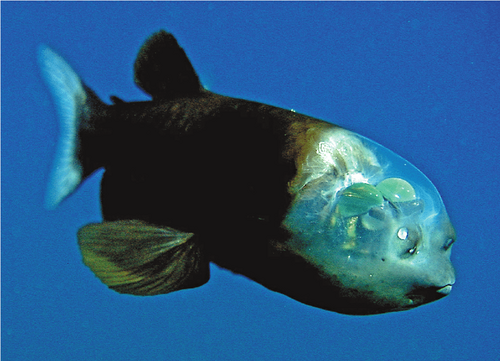
Barreleye
The Atlantic bluefin tuna (Thunnus thynnus) is a highly migratory, large pelagic fish known for its incredible speed, size, and commercial value. Prized for sushi and sashimi, this species plays a vital role in the marine ecosystem and faces significant conservation challenges.
5 10 years
Lifespan
15 cm
Length
Least Concern
Conservation Status
5 km/h
Swimming speed
Carnivorous
Diet
Local Migration
Migration
Appearance Overview
The Atlantic bluefin tuna is renowned for its large, streamlined body, built for speed and endurance.
Color
Dark metallic blue on top, with a silvery underside
Fins
Two dorsal fins, the first depressible; small, yellow finlets running from the second dorsal and anal fins to the tail
Body Shape
Torpedo-shaped, with a strong, crescent-shaped tail
Length
Up to 13 feet (4 meters)
Weight
Up to 2,000 lbs (907 kg)
Diet
Carnivorous, feeding on a variety of fish, squid, eels, and crustaceans.
Feeding Behavior
Highly active predator, using speed and agility to hunt. They are also known to cooperate in groups to herd and capture prey.
Social Behavior
Forms large schools, especially during migration and spawning. Schools can be mixed with other tuna species.
Commercial Relevance
Extremely high value, particularly in the sushi and sashimi markets in Japan. Overfishing has significantly impacted its economic viability.
Conservation measures
International fishing quotas, restrictions on fishing gear, and marine protected areas. Conservation efforts are ongoing, with some stocks showing signs of recovery.
Status
Varies by stock; some populations are considered endangered or critically endangered, while others are near threatened or of least concern.
Threats
Overfishing is the primary threat. Other threats include bycatch in fishing gear, habitat degradation, and climate change affecting prey distribution.
Habitat Distribution
Depth Range
0-1,000 meters (0-3,280 feet), but most commonly found in the upper layers of the ocean.
Geographic Range
Found throughout the North Atlantic Ocean, including the Mediterranean Sea.
Preferred Environment
Primarily pelagic, inhabiting temperate and subtropical waters. They prefer open ocean but can also be found in coastal areas.
Reproduction and Life Cycle
Breeding Habits
Spawns in two main areas: the Mediterranean Sea and the Gulf of Mexico. Spawning typically occurs in warm waters from spring to summer.
Development Stages
Eggs hatch into larvae, which develop rapidly in plankton-rich waters. Juveniles grow quickly, transitioning through several life stages before reaching adulthood.
Fecundity
Females are highly fecund, capable of releasing up to 30 million eggs per spawning season.
Maturity Age
Varies by population; typically reaches sexual maturity between 4-8 years of age.
Faqs about Barreleye
Where are Atlantic bluefin tuna found?
Atlantic bluefin tuna are found in the Atlantic Ocean, from the Mediterranean Sea to the Gulf of Mexico and the coast of Norway.
What do Atlantic bluefin tuna eat?
Atlantic bluefin tuna primarily eat fish, squid, crustaceans, and eels.
What is the biggest threat to Atlantic bluefin tuna?
The main threat to Atlantic bluefin tuna is overfishing, driven by high demand in the sushi market.
How long do Atlantic bluefin tuna live?
They can live up to 40 years, although many don't reach this age due to fishing pressure.
When do Atlantic bluefin tuna reach maturity?
They reach sexual maturity at around 4-8 years of age, depending on the population.
Are Atlantic bluefin tuna migratory?
Yes, they are highly migratory, traveling long distances across the Atlantic Ocean for feeding and spawning.
How many eggs can a female bluefin tuna lay?
A female can release up to 30 million eggs per spawning season.
How fast can Atlantic bluefin tuna swim?
They are among the fastest fish in the ocean, capable of bursts of speed up to 40-60 mph.
What makes bluefin tuna so fast?
Their streamlined body, powerful muscles, and specialized fins enable high speeds and efficient swimming.
Are Atlantic bluefin tuna endangered?
Conservation status varies; some populations are endangered, while others are recovering due to strict management.
Copyright @ Nature Style Limited. All Rights Reserved.
 English
English